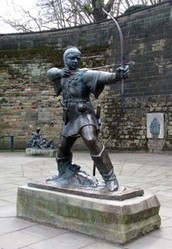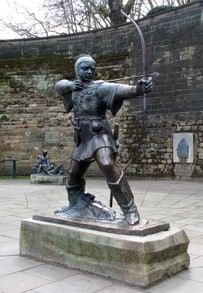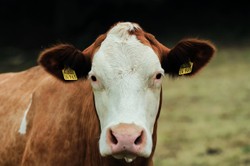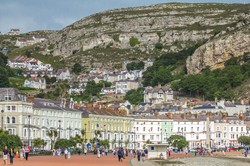The outlaw Robin Hood is often portrayed in films and books as a fallen member of the aristocracy but, as Steve Rogerson shows here, this is a fairly recent idea. Looking further back, if he did exist he was more likely a member of the dispossessed whom the nobility wanted to claim as their own when his popularity increased.

Who was the real Robin Hood?
How accurate is the depiction of Robin Hood in films and books?
Robin Hood is portrayed in books, films and televisions programmes as the fallen hero, a member of the nobility who was outcast and then fought back against tyranny. Yet this version of Robin Hood is a relatively recent one and delving into history suggests that if Robin Hood did exist he was more likely a peasant or at best a small land owner.
Modern Robin Hood
The idea that Robin Hood was a member of the aristocracy can be traced back to 1598 and a play by Andrew Munday called: “The Downfall of and Death of Robert, Earl of Huntingdon.”
As the April 2010 Robin Hood special issue of Nottingham Arrow says: “In the 16th century, Robin was given a leg up the social ladder when poets and playwrights turned him from an ordinary man to a fallen nobleman – either Robert Fitzooth (Earl of Huntingdon) or Robert of Loxley.”
This gentrification of Robin Hood continued and in 1795 William Stukeley, a fellow of the Royal Society, made up a noble pedigree for Robin Hood and it is this fiction that is now repeated regularly in modern Robin Hood films and books.
Old Robin Hood
Historian Judy Cox has traced early references to Robin Hood in ballads written in the 1400s in which can be found the archery contests, clever disguises, daring rescues and fighting evil sheriffs that are the staple diet of modern television and film versions of Robin Hood.
Probably the best known of these ballads is A Lytell Geste of Robin Hood in which we find hints to how he viewed the authority when Robin Hood tells Little John not to hurt farmers or yeomen “but these bishops and these archbishops, you shall beat and bind, and the high sheriff of Nottingham, keep him on your mind”.
Another reference to Robin Hood’s status in society can be found in Scotichronicon, a history of Scotland and England written by Walter Bower in the 1440s in which he says about 1296: “Then arose the famous murderer, Robert Hood, as well as Little John, together with their accomplices from among the dispossessed, whom the foolish populace are so inordinately fond of celebrating both in tragedy and comedy.”
Robin Hood Trivia
Maid Marian was originally Maid Matilda and the characters Robin Hood, Friar Tuck and Maid Matilda used to be central characters in May Day masquerades. So worried were the authorities of the populace making heroes out of outlaws that the Scottish parliament in 1555 banned any annual celebrations involving Robin Hood and similar characters.
Did Robin Hood Exist?
The use of Robin Hood as a nickname has many references in history such as armed robber William Le Fevere in 1261 who changed his name to William Robehood. In the York Azzizes of 1225 there is reference to an outlaw called Robert Hod who changed his name to Hobbehod. Several other references to similar names suggest that criminals would change their name to Robin Hood to hide their true identity. That they did so suggests there was someone originally of that or a similar name.
Sources
- Robin Hood: Earl, Outlaw or Rebel, by Judy Cox (International Socialism 78, March 1998)
- Nottingham Arrow April 2010: The Return of Robin Hood and His Merry Men
- Robin Hood by JC Holt (Thames and Hodson, 1991)
You might also like
A Strong Woman's StoryJane Evans went to War, but fought no one, for her mission was mercy and kind...
Sarn Helen. Through Wales on footSarn Helen is a Roman route which travels Wales from South to North, and the...







 KZine Issue 31: Review of October 2021 Issueon 11/07/2021
KZine Issue 31: Review of October 2021 Issueon 11/07/2021
 KZine Issue 30: Review of June 2021 Issueon 07/05/2021
KZine Issue 30: Review of June 2021 Issueon 07/05/2021
 KZine Issue 29: Review of February 2021 Issueon 02/23/2021
KZine Issue 29: Review of February 2021 Issueon 02/23/2021
 KZine Issue 28: Review of September 2020 Issueon 10/01/2020
KZine Issue 28: Review of September 2020 Issueon 10/01/2020



Comments
SteveRogerson, Thank you for product lines, pretty pictures and practical information.
The earlier sources that you reference are persuasive.
In particular, it intrigues me where you say, per the Nottingham Arrow April 2010 Robin Hood special issue, that “In the 16th century, Robin was given a leg up the social ladder when poets and playwrights turned him from an ordinary man to a fallen nobleman – either Robert Fitzooth (Earl of Huntingdon) or Robert of Loxley."
Which of the tumultuous happenings during that time period would have prompted such a transformation?